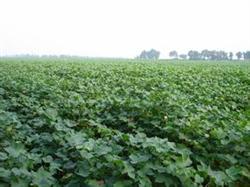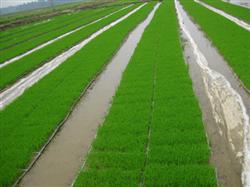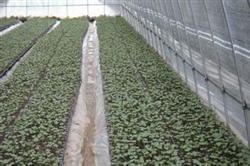It is necessary to master key techniques to grow cotton well.

If you want to grow cotton well, you should master the following key techniques. First, strictly control the sowing quality. 1. Select high-quality and high-yield varieties. Select the excellent varieties promoted by the local agricultural technology department. 2. Sow seeds before sowing. On a sunny day, spread the seeds on non-cement ground and sow them in the sun for 5 days to promote post-ripening and improve the germination rate. 3. Sow seeds at the right time. It is generally mastered that the ground temperature is stable at 5 cm and the sowing begins at 16 ℃. The suitable sowing time of plastic film cotton is April 20-30, and that of open field cotton is after April 25. 4. Choose the suitable sowing method. Generally, sandy soil should be sowed first and then covered with plastic film to prevent soil surface from hardening and pressing seedlings; clayey soil and saline-alkali soil should be covered with plastic film before sowing, which is helpful to improve the ground temperature and prevent salt return. The seedlings should be released in time after emergence to prevent the seedlings from being burned. 5. Increase the amount of sowing. The amount of seed used for artificial hole sowing is 1.5 kg per mu, and 4 seeds are sown on demand for each hole and placed centrally, while the amount of seed used for machine sowing is 2.5kg per mu. Second, strengthen scientific management. 1. Determine the appropriate density. Different planting densities were selected according to different varieties, different soil fertility and different cultivation methods. For example, the general soil fertility of Ji 668 varieties is 2500Mu / mu, more than 3500 plants / mu in barren land and dry land, and about 2000 plants / mu in simplified cultivation plots. Jiza 3268, 2000,200 plants per mu under conventional cultivation and about 1800 plants per mu under simplified cultivation. The varieties of Jiza 566 were 1800 plants per mu under conventional cultivation and about 1500 plants per mu under simplified cultivation. There are more than 3500 DP99B plants per mu. 2. hit the top at the right time. The plot under conventional cultivation was topped on July 15-20, and the plot for simplified cultivation was topped on July 10-15. DP99B should also pay attention to hitting the top of the group in the first and middle of August. 3. Uncover the film in time. In order to prevent premature senility in the later stage, the film should be uncovered in time, and the time should be carried out in late June. 3. Popularizing applicable techniques (1) balanced fertilization technology should be vigorously popularized in order to improve the comprehensive stress resistance of cotton. According to the principle of "suitable nitrogen, increase phosphorus, heavy potassium, supplement micro", the ratio of nitrogen, phosphorus and potassium was adjusted to 1V / L / 0.5 / 0.6 / 1. At the same time, boron, zinc and other trace fertilizers were applied to improve the peach setting rate. 1. Re-apply base fertilizer. All phosphorus and potash fertilizers and 50% Mel 60% nitrogen fertilizer are applied at the bottom, with 10 kg of urea, 15 kg of diammonium phosphate, 20 kg of potassium sulfate, 1 kg of boron fertilizer and 2 square meters of mature organic fertilizer. 2. Topdressing flower and boll fertilizer. In the first and middle of July, 15 kg of urea was applied per mu, and 15 kg of diammonium phosphate could be applied to the plots with low base fertilizer and poor growth. It should be watered in time after topdressing, and those without water should be fertilized while it rains. 3. Foliar spraying fertilizer. In the middle and later period, 0.5ml / mu of urea, 0.2kg of potassium dihydrogen phosphate or 15ml of rich potassium were sprayed with a small amount of boric acid and 50kg of water. 7Murray was sprayed once every 10 days, and 2murine was sprayed for 3 times. (2) systematic regulation technology is beneficial to root growth, increase stress resistance, control plant growth, coordinate the relationship between nutrition and reproductive growth, and reduce bud and boll shedding. Therefore, it is necessary to promote the systematic blending technology of cotton and pay special attention to the chemical control of bud stage. Generally grasp the principle of "a small amount for many times, light in front and heavy, and increment step by step". During the whole growth period, Juan was sprayed 3-4 times: the first time was in mid-June, the usage was 1.5 g / mu; the second was in the first ten days of July, the usage was 2.0 g / mu; the third time was at the end of July. Make a strict control of sowing quality, do a good job in the control of diseases, pests and weeds. Emphasis should be placed on the control of aphids, thrips, cotton bollworms and bug bugs in the seedling stage. Aphids and thrips can be treated with imidacloprid, and cotton bollworm and bug bug can be sprayed with Lesben and Sebokai at 1:1 and diluted 1500Mel 2000 times. 2. Disease. Adjusting sowing date, avoiding low temperature, seed or soil treatment, spraying Bordeaux solution and carbendazim were selected to control Verticillium wilt and anthracnose at seedling stage. Red leaf yellow blight was solved by increasing potash fertilizer. 3. Grass damage. Use 48% trifluralin EC 70 ml and 50 kg water per mu, spray on the ground before sowing, and rake 3-5 cm concrete. Acetochlor or Dur can also be used for weeding.
- Prev

How to apply fertilizer to rice seedlings during the stinging period
"Spring thunder rings, all things grow". Since ancient times, our country has attached great importance to stinging solar terms, and many agricultural activities are about to begin, and the most important agricultural work is "planting seedlings." When the stinging season enters the season of raising rice seedlings, as the saying goes, "half of the rice seedlings are good". In order to obtain high yield of rice, we must first cultivate enough.
- Next

How to control cotton falling peach
There are many reasons for the emergence rate of cotton, including the influence of weather on cotton maturity during last year's cotton harvest season and the appropriateness of cotton seedling raising technology. In terms of last year's climate, the weather during cotton harvest is generally good, and it is good for cotton seed maturity.
Related
- The first cup of black tea in spring, the flavor and history of tea gardens in Kenya, Africa
- The computer can not only choose potatoes, but also grow tea rice. AI will grow winter oolong tea champion.
- It is not only the inflated tea bitten by insects, but also engraved with the four seasons tea in Beipu.
- The Oriental Beauty Tea Festival in Zhuxian County takes the stage at the weekend to experience the plus-size feast of oil tea.
- & quot; Oriental Beauty Tea & Exploration of Emei in Hsinchu, the hometown of quot;
- The new variety of strawberry "Tainong 1" dessert is the first choice with mellow aroma. Crimson gorgeous
- History of Tea in Taiwan: from Wild Inner Mountain to Export Tea Garden
- Two types of Taiwan Oriental Beauty Black Tea won the British three-Star Award for Childhood Tea Xiang Zhang Jiaqi changed from pilot to champion tea maker.
- Banana species and varieties: the planting history of Taiwan Xianren banana and dwarf banana is long, is banana disease resistant?
- Coffee planting Technology: Qianjie Coffee from Seedling to harvesting

